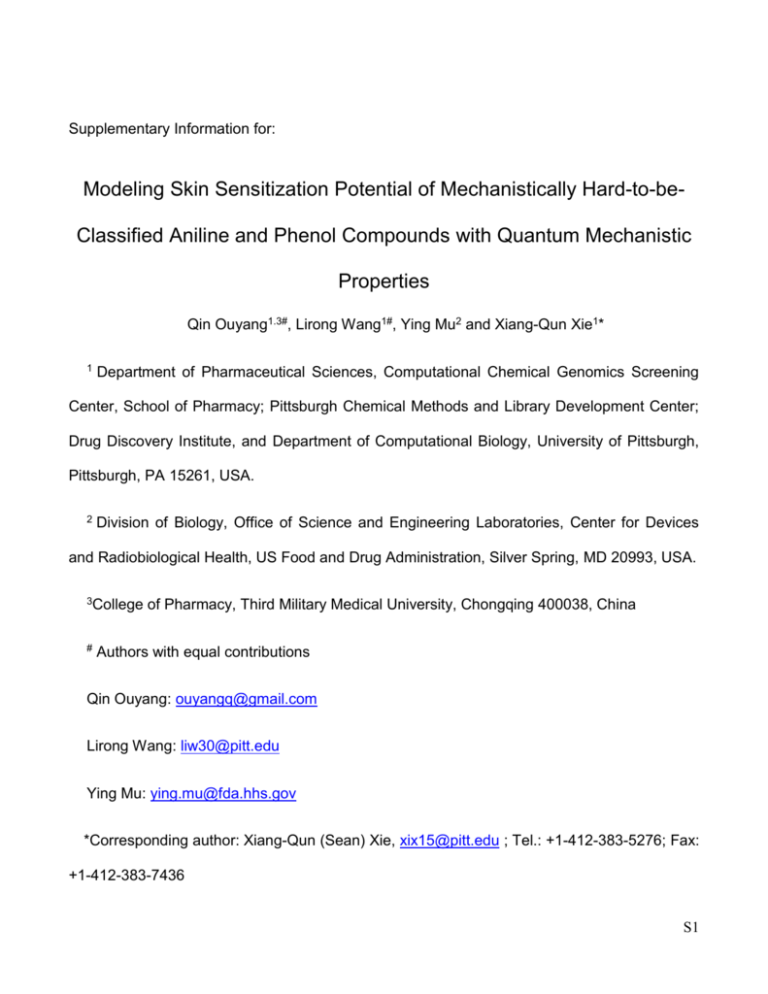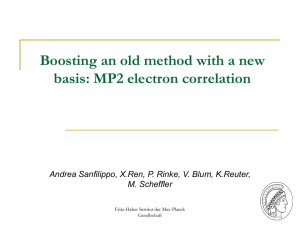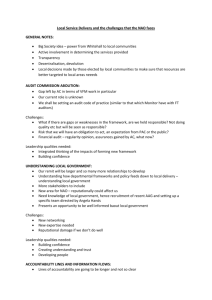file - BioMed Central
advertisement

Supplementary Information for: Modeling Skin Sensitization Potential of Mechanistically Hard-to-beClassified Aniline and Phenol Compounds with Quantum Mechanistic Properties Qin Ouyang1.3#, Lirong Wang1#, Ying Mu2 and Xiang-Qun Xie1* 1 Department of Pharmaceutical Sciences, Computational Chemical Genomics Screening Center, School of Pharmacy; Pittsburgh Chemical Methods and Library Development Center; Drug Discovery Institute, and Department of Computational Biology, University of Pittsburgh, Pittsburgh, PA 15261, USA. 2 Division of Biology, Office of Science and Engineering Laboratories, Center for Devices and Radiobiological Health, US Food and Drug Administration, Silver Spring, MD 20993, USA. 3College # of Pharmacy, Third Military Medical University, Chongqing 400038, China Authors with equal contributions Qin Ouyang: ouyangq@gmail.com Lirong Wang: liw30@pitt.edu Ying Mu: ying.mu@fda.hhs.gov *Corresponding author: Xiang-Qun (Sean) Xie, xix15@pitt.edu ; Tel.: +1-412-383-5276; Fax: +1-412-383-7436 S1 Table 1. Summary of the Calculated Reactivity Parameters, Predicted Values, and Experimentally Determined Data for 63 Chemicals[1-11]. ( ID 130 : Substituted Aniline, ID 31-63 : Substituted Phenols) ϵLUMO ϵHOMO (hartree) (hartree) 1 0.152 -0.288 0.672 Y 1 0.139 -0.260 1.100 NC1=CC=C(C=C1)CC2=CC=C(N)C=C2 Y 1 0.139 -0.266 1.008 4,4-diaminodiphenylether NC1=CC=C(C=C1)OC2=CC=C(N)C=C2 Y 1 0.132 -0.262 1.069 104147-322 3,5-Dichloro-4-(1,1,2,2tetrafluoroethoxy)aniline NC1=CC(Cl)=C(OC(F)(F)C(F)F)C(Cl)=C1 N 0.105 -0.316 0.243 6 106-50-3 p-phenylenediamine NC1=CC=C(N)C=C1 Y 0.29 1/7/9 0.147 -0.254 1.192 7 108-45-2 3-Phenylenediamine NC1=CC=CC(N)=C1 Y 0.49 6/9 0.160 -0.273 0.901 8 121-57-3 Sulphanilic acid O=S(O)(C(C=C1)=CC=C1N)=O N 6 0.098 -0.322 0.151 9 123-30-8 p-aminophenol NC1=CC=C(O)C=C1 Y 1 0.140 -0.271 0.932 10 150-13-0 4-Aminobenzoic acid OC(C1=CC=C(N)C=C1)=O N 5 0.101 -0.306 0.396 11 20048-27-5 Bandrowski's base NC1=CC=C(/N=C2C=C(N)/C(C=C\2N)=N/ C3=CC=C(N)C=C3)C=C1 Y 0.04 2 0.059 -0.251 1.238 12 2835-95-2 5-Amino-2-methylphenol OC1=CC(N)=CC=C1C Y 3.4 2 0.154 -0.275 0.871 13 2835-99-6 4-amino-3-methyl-phenol NC1=CC=C(O)C=C1C Y 1.45 2 0.144 -0.267 0.993 14 2871-01-4 2-(4-Amino-2nitrophenylamino)-ethanol NC1=CC=C(NCCO)C([N+]([O-])=O)=C1 Y 2.2 6/7/9 0.061 -0.284 0.733 15 369-36-8 2-Fluoro-5-nitroaniline NC1=CC([N+]([O-])=O)=CC=C1F N 2 0.056 -0.325 0.106 16 5307-14-2 2-nitro-p-phenylenediamine O=[N+]([O-])C1=CC(N)=CC=C1N Y 1/7/9 0.066 -0.279 0.809 17 537-65-5 4,4-diaminodiphenylamine NC1=CC=C(C=C1)NC(C=C2)=CC=C2N Y 1 0.140 -0.243 1.360 18 538-41-0 4,4-diaminoazobenzene NC(C=C1)=CC=C1/N=N/C2=CC=C(N)C= Y 1 0.084 -0.258 1.131 ID Cas # Name SMILESa Sensitizerb 1 100-63-0 phenylhydrazine NNC1=CC=CC=C1 Y 2 101-54-2 4-aminodiphenylamine NC1=CC=C(C=C1)NC2=CC=CC=C2 3 101-77-9 4,4-diaminodiphenylmethane 4 101-80-4 5 EC3 0.4 Reference P S2 C2 19 591-27-5 3-Aminophenol OC1=CC=CC(N)=C1 Y 4/9/6 0.152 -0.289 0.656 20 60-09-3 4-aminophenylazobenzene NC(C=C1)=CC=C1/N=N/C2=CC=CC=C2 Y 1 0.074 -0.276 0.855 21 610-81-1 4-Amino-3-nitrophenol NC1=CC=C(O)C=C1[N+]([O-])=O Y 0.2 2 0.060 -0.297 0.534 22 62-53-3 Aniline NC1=CC=CC=C1 Y 89 5,11 0.149 -0.286 0.702 23 6358-09-4 2-Amino-6-chloro-4nitrophenol NC1=CC([N+]([O-])=O)=CC(Cl)=C1O Y 6.85 2/9 0.058 -0.322 0.151 24 63-74-1 Sulfanilamide O=S(N)(C(C=C1)=CC=C1N)=O N 6 0.122 -0.307 0.381 25 79456-26-1 NC1=NC=C(C(F)(F)F)C=C1Cl N 3 0.093 -0.326 0.090 26 82560-06-3 3-Chloro-5-(trifluoromethyl)2-pyridinamine 3-(1-Ethyl-1-methylpropyl)-5isoxazolamine NC1=CC(C(C)(CC)CC)=NO1 N 7 0.162 -0.313 0.289 27 95-55-6 2-Aminophenol OC1=CC=CC=C1N Y 0.5 6/7/8/9 0.149 -0.280 0.794 28 99-56-9 4-Nitro-1,2-benzenediamine NC1=CC=C([N+]([O-])=O)C=C1N Y 0.05 2 0.073 -0.306 0.396 29 106-47-8c 4-Chloroaniline NC1=CC=C(Cl)C=C1 Y* 8,10 0.137 -0.289 0.656 30 94-09-7 Benzocaine O=C(c1ccc(N)cc1)OCC N 8 0.105 -0.303 0.442 31 1166-52-5 Lauryl gallate O=C(C1=CC(O)=C(O)C(O)=C1)OCCCCC CCCCCCC Y 0.3 4/9 0.090 -0.322 0.151 32 10597-60-1 Hydroxytyrosol OC1=CC=C(CCO)C=C1O Y 0.6 2 0.136 -0.305 0.412 33 108-46-3 Resorcinol OC1=CC=CC(O)=C1 Y* 1/9 0.144 -0.307 0.381 34 1154-59-2 3,3',4',5Tetrachlorosalicylanilide OC1=C(Cl)C=C(Cl)C=C1C(NC2=CC=C(C l)C(Cl)=C2)=O Y 1 0.065 -0.322 0.151 35 118-58-1 Benzyl salicylate O=C(C1=CC=CC=C1O)OCC2=CC=CC= C2 Y 2 0.081 -0.323 0.136 36 121-32-4 Ethyl vanillin O=CC1=CC=C(O)C(OCC)=C1 N 6 0.083 -0.317 0.228 37 121-33-5 Vanillin OC1=CC=C(C=O)C=C1OC N 6 0.085 -0.313 0.289 2.9 S3 38 123-31-9 1,4-Hydroquinone OC1=CC=C(O)C=C1 Y 39 150-75-4 4-(Methylamino)phenol sulphate OC1=CC=C(NC)C=C1 40 15128-82-2 3-Hydroxy-2-nitropyridine 41 1776-30-3 42 0.1 4/9 0.131 -0.291 0.626 Y 6 0.143 -0.269 0.962 OC1=CC=CN=C1[N+]([O-])=O N 2 0.041 -0.362 -0.461 2',4'-Dihydroxychalcone O=C(C1=CC=C(O)C=C1O)/C=C/C2=CC= CC=C2 Y 0.56 2 0.051 -0.312 0.304 2050-14-8 2,2'-Azodiphenol OC1=CC=CC=C1/N=N/C2=CC=CC=C2O Y 27.9 2 0.053 -0.294 0.580 43 2657-25-2 4'-Hydroxychalcone O=C(C1=CC=C(O)C=C1)/C=C/C2=CC=C C=C2 Y 0.00 2 2 0.056 -0.310 0.335 44 2785-87-7 Dihydroeugenol COC1=CC(CCC)=CC=C1O Y 12.4 5 6/7/9 0.148 -0.288 0.672 45 526-37-4 atranol O=Cc1c(O)cc(cc1O)C Y 0.6 2 0.081 -0.316 0.243 46 55302-96-0 CC1=CC=C(NCCO)C=C1O Y 0.4 6/7/9 0.160 -0.283 0.748 47 55845-90-4 O=C(C1=CC=CC(O)=C1)CN(CC2=CC=C C=C2)CC.Cl N 3 0.085 -0.316 0.243 48 619-14-7 O=C(C(C=C1O)=CC=C1[N+]([O-])=O)O N 2 0.011 -0.371 -0.598 49 65235-31-6 2-Methyl-5hydroxyethylaminophenol (N-Benzyl-N-ethylamino)-3'hydroxyacetophenone hydrochloride 3-Hydroxy-4-nitrobenzoic acid 3-Nitro-N-(2-hydroxyethyl)-4aminophenol OC1=CC=C(NCCO)C([N+]([O-])=O)=C1 Y 2 0.109 -0.300 0.488 50 69-72-7 Salicylic acid OC1=CC=CC=C1C(O)=O N 5 0.011 -0.343 -0.170 51 80-05-7 bisphenol A CC(C1=CC=C(O)C=C1)(C)C2=CC=C(O) C=C2 Y 1 0.132 -0.287 0.687 52 87-86-5 Pentachlorophenol ClC1=C(O)C(Cl)=C(Cl)C(Cl)=C1Cl Y 5 0.077 -0.341 -0.139 53 90-15-3 1-Naphthol OC1=CC=CC2=CC=CC=C21 Y 1.3 6/7/8 0.104 -0.274 0.886 54 93-51-6 2-Methoxy-4-methyl-phenol COC1=CC(C)=CC=C1O Y 5.8 6/7/8/9 0.146 -0.288 0.672 55 94-13-3 Propylparaben O=C(C1=CC=C(O)C=C1)OCCC N 6 0.096 -0.329 0.044 56 97-53-0 Eugenol OC1=CC=C(CC=C)C=C1OC Y 5/7/8/9 0.137 -0.296 0.549 0.07 13.9 5 S4 57 97-54-1 Isoeugenol OC1=CC=C(/C=C/C)C=C1OC Y 58 98-29-3 p-tert-butylcatechol OC1=CC(C(C)(C)C)=CC=C1O 59 99-76-3 Methyl 4-hydroxybenzoate 60 99-96-7 61 3.5 5/7/8/9 0.120 -0.277 0.840 Y 1 0.141 -0.293 0.595 OC1=CC=C(C(OC)=O)C=C1 N 6 0.096 -0.329 0.044 4-Hydrobenzoic acid OC1=CC=C(C(O)=O)C=C1 N 6 0.092 -0.341 -0.139 119-36-8 Methyl salicylate OC1=CC=CC=C1C(OC)=O N 4 0.086 -0.326 0.090 62 186743-260 3-Methyleugenol OC1=C(C)C=C(CC=C)C=C1OC Y 8,11 0.143 -0.294 0.580 63 831-82-3 4-Phenoxyphenol OC1=CC=C(OC2=CC=CC=C2)C=C1 Y 0.124 -0.293 0.595 32 8 b The SMILES was generated from Chembiodraw Ultra V12.0 (PerkinElmer Informatics Desktop Software). All the Y/N correspond to a experimental data from the references cited. cIn the ref 8, 4-Chloroaniline was reported as no-sensitizer. Table 2. Summary of the Predicted Value and MetaADEDB Data for 53 FDA Approved Drugs. DrugBank ID Name SMILESd 1 DB01298 Sulfacytine CCN1C=CC(NS(=O)(=O)C2=CC=C(N)C=C2)=NC1=O 0.202 N Y 2 DB06288 Amisulpride O=C(NCC1N(CC)CCC1)c2cc(c(N)cc2(OC))S(=O)(=O)CC 0.222 N Y 3 DB06150 Sulfadimethoxine 0.297 N Y 4 DB00701 Amprenavir 0.308 N Y 5 DB01581 Sulfamerazine O=S(=O)(Nc1nc(nc(OC)c1)OC)c2ccc(N)cc2 CC(C)CN(C[C@@H](O)[C@H](CC1=CC=CC=C1)NC(=O)O[C@H]1 CCOC1)S(=O)(=O)C1=CC=C(N)C=C1 CC1=NC(NS(=O)(=O)C2=CC=C(N)C=C2)=NC=C1 N Y 6 DB01582 Sulfamethazine CC1=CC(C)=NC(NS(=O)(=O)C2=CC=C(N)C=C2)=N1 N Y 7 DB00576 Sulfamethizole CC1=NN=C(NS(=O)(=O)C2=CC=C(N)C=C2)S1 N Y 8 DB00259 Sulfanilamide NC1=CC=C(C=C1)S(N)(=O)=O N Y 9 DB01015 Sulfamethoxazole CC1=CC(NS(=O)(=O)C2=CC=C(N)C=C2)=NO1 N Y 10 DB01299 Sulfadoxine COC1=NC=NC(NS(=O)(=O)C2=CC=C(N)C=C2)=C1OC 0.348 0.369 0.38 0.383 0.384 0.389 N Y P Other allergic groupa Sulfonamide Derivativeb MetaA DEDBc Y Y S5 0.4 N 0.415 N Y 0.427 N Y 0.448 N Y COC1=NC=CN=C1NS(=O)(=O)C1=CC=C(N)C=C1 0.466 N Y CC1=C(C)N=C(NS(=O)(=O)C2=CC=C(N)C=C2)O1 0.718 N 0.7 N Y 11 DB00891 Sulfapyridine NC1=CC=C(C=C1)S(=O)(=O)NC1=CC=CC=N1 12 DB06147 Sulfathiazole 13 DB01264 Darunavir 14 DB00263 15 DB00664 16 DB08798 Sulfisoxazole Sulfametopyrazin e Sulfamoxole O=S(=O)(Nc1nccs1)c2ccc(N)cc2 [H][C@@]12CCO[C@]1([H])OC[C@@H]2OC(=O)N[C@@H](CC1=C C=CC=C1)[C@H](O)CN(CC(C)C)S(=O)(=O)C1=CC=C(N)C=C1 CC1=NOC(NS(=O)(=O)C2=CC=C(N)C=C2)=C1C 17 DB00250 Dapsone NC1=CC=C(C=C1)S(=O)(=O)C1=CC=C(N)C=C1 18 DB00509 Dextrothyroxine 19 DB08810 Cinitapride 20 DB00279 Liothyronine N[C@H](CC1=CC(I)=C(OC2=CC(I)=C(O)C(I)=C2)C(I)=C1)C(O)=O O=C(NC1CCN(CC1)CC2CC=CCC2)c3cc(c(N)cc3(OCC))[N+](=O)[ O-] N[C@@H](CC1=CC(I)=C(OC2=CC(I)=C(O)C=C2)C(I)=C1)C(O)=O 21 DB01161 Chloroprocaine CCN(CC)CCOC(=O)C1=C(Cl)C=C(N)C=C1 0.306 N 22 DB00721 Procaine CCN(CC)CCOC(=O)C1=CC=C(N)C=C1 0.435 N 23 DB01086 Benzocaine CCOC(=O)C1=CC=C(N)C=C1 0.442 N 24 DB00135 L-Tyrosine N[C@@H](CC1=CC=C(O)C=C1)C(O)=O 0.274 N 25 DB00388 Phenylephrine CNC[C@H](O)C1=CC(O)=CC=C1 0.274 N 26 DB00892 Oxybuprocaine CCCCOC1=C(N)C=CC(=C1)C(=O)OCCN(CC)CC 0.482 N 27 DB01233 Metoclopramide 0.487 N 28 DB00604 Cisapride 29 DB00807 Proparacaine CCN(CC)CCNC(=O)C1=CC(Cl)=C(N)C=C1OC CO[C@H]1CN(CCCOC2=CC=C(F)C=C2)CC[C@H]1NC(=O)C1=CC (Cl)=C(N)C=C1OC CCCOC1=C(N)C=C(C=C1)C(=O)OCCN(CC)CC 30 DB00963 Bromfenac NC1=C(CC(O)=O)C=CC=C1C(=O)C1=CC=C(Br)C=C1 0.552 N 31 DB01035 Procainamide 0.561 N 32 DB00486 Nabilone 33 DB01407 Clenbuterol CCN(CC)CCNC(=O)C1=CC=C(N)C=C1 [H][C@@]12CC(=O)CC[C@@]1([H])C(C)(C)OC1=CC(=CC(O)=C21 )C(C)(C)CCCCCC CC(C)(C)NCC(O)C1=CC(Cl)=C(N)C(Cl)=C1 34 DB06802 Nepafenac 0.683 N 35 DB00470 Dronabinol 36 DB00295 Morphine O=C(N)Cc2cccc(C(=O)c1ccccc1)c2(N) [H][C@@]12C=C(C)CC[C@@]1([H])C(C)(C)OC1=CC(CCCCC)=CC (O)=C21 [H][C@@]12OC3=C(O)C=CC4=C3[C@@]11CCN(C)[C@]([H])(C4)[ C@]1([H])C=C[C@@H]2O Y Y Y -0.093 N 0.169 N -0.001 N Y 0.489 N 0.519 N 0.411 N 0.589 N Y 0.549 N 0.580 N Y S6 [H][C@@]12OC3=C(O)C=CC4=C3[C@@]11CCN(C)[C@]([H])(C4)[ C@]1([H])CCC2=O [H][C@@]12CCCC[C@@]11CCN(CC=C)[C@@H]2CC2=C1C=C(O) C=C2 CCOC(=O)C1(CCN(CCC2=CC=C(N)C=C2)CC1)C1=CC=CC=C1 CC(C)CCC[C@@H](C)CCC[C@@H](C)CCC[C@]1(C)CCC2=C(O1) C(C)=C(C)C(O)=C2C OC1=CC=C(C=C1)C1=C(C(=O)C2=CC=C(OCCN3CCCCC3)C=C2) C2=C(S1)C=C(O)C=C2 NC1=CC2=NC3=C(C=CC(N)=C3)C=C2C=C1 0.595 N 37 DB00327 Hydromorphone 38 DB00504 Levallorphan 39 DB00913 Anileridine 40 DB00163 Vitamin E 41 DB00481 Raloxifene 42 DB01123 Proflavine 43 DB00359 NC1=CC=C(C=C1)S(=O)(=O)NC1=NC=CC=N1 44 DB00233 NC1=CC(O)=C(C=C1)C(O)=O 0.321 Y 45 DB00480 Sulfadiazine Aminosalicylic Acid Lenalidomide 1.092 N 0.339 Y NC1=CC=CC2=C1CN(C1CCC(=O)NC1=O)C2=O 46 DB00345 Aminohippurate 47 DB00522 Bentiromide O=C(O)CNC(=O)c1ccc(N)cc1 OC(=O)C1=CC=C(NC(=O)[C@H](CC2=CC=C(O)C=C2)NC(=O)C2= CC=CC=C2)C=C1 0.405 Y 0.427 Y 48 DB00357 49 DB00964 Aminoglutethimid e Apraclonidine 50 DB01208 Sparfloxacin 51 DB00244 52 53 a Y 0.611 N 0.825 N 0.855 N 0.977 N Y Y Y Y 0.32 Y CCC1(CCC(=O)NC1=O)C1=CC=C(N)C=C1 0.573 Y 0.576 Y Mesalazine NC1=CC(Cl)=C(NC2=NCCN2)C(Cl)=C1 C[C@H]1CN(C[C@@H](C)N1)C1=C(F)C(N)=C2C(=O)C(=CN(C3CC 3)C2=C1F)C(O)=O NC1=CC(C(O)=O)=C(O)C=C1 DB00316 Acetaminophen CC(=O)NC1=CC=C(O)C=C1 DB00255 Diethylstilbestrol CCC(=C(CC)C1=CC=C(O)C=C1)C1=CC=C(O)C=C1 0.638 Y 0.695 Y 0.748 Y 0.794 Y Y Y means the drug: (1) has group( s) to form a SN2 electrophile, SNAr electrophile, Schiff base former, and acylation agent, and Michael receptor ; or (2) has two OH and NH2 substituents at aromatic rings. Other drugs are labeled as N. b Y means the compounds are sulfonamide derivatives.c Y means the keywords “allergic dermatitis” can be found in the drug’s side effect report from MetaADEDB. d Y means the keywords “allergic dermatitis” can be found in the drug’s side effect report from MetaADEDB. S7 The correlation between EC3 Values and ϵHOMO The LLNA data as a quantitative endpoint, posed a semi-dose-dependent manner, allows for modeling of potency. The EC3 values from the reported LLNA experiments of 9 chemicals were also collected as shown in Table 1. The calculated energy of HOMO (ϵHOMO) was further employed for prediction the EC3 values of these 9 chemicals. The final linear regression model is shown in Formula S1 and the plot of the correlation between experimental and predicted pEC3 were shown in Figure S1A. pEC3 = -13.16 – 49.44* ϵHOMO (Hartree) (S1) For most chemicals, their -logEC3 values correlate with P values quite well, but for aniline, its –logEC3 value is much less potent than its P value predicted. This may indicate that the initial oxidation of aniline, which is quite fast, is not in this case the rate-determining step for protein haptenation. Excluding aniline results in a significantly improved model for the remaining 8 chemicals (Formula S2 and Figure S1B). pEC3 = -14.21 – 52.67 * ϵHOMO (Hartree) (S2) Figure S1. The correlation between experimental (y-axis) and predicted (x-axis) pEC3 values of 9 chemicals using ϵHOMO as the model descriptor(A. considering all of the data; B. excluding aniline). S8 References: 1. 2. 3. 4. 5. 6. 7. 8. 9. 10. 11. Barratt MD, Langowski JJ: Validation and subsequent development of the DEREK skin sensitization rulebase by analysis of the BgVV list of contact allergens. Journal of Chemical Information and Computer Sciences 1999, 39(2):294-298. Kern PS, Gerberick GF, Ryan CA, Kimber I, Aptula A, Basketter DA: Local Lymph Node Data for the Evaluation of Skin Sensitization Alternatives: A Second Compilation. Dermatitis 2010, 21(1):8-32. Payne MP, Walsh PT: Structure-Activity-Relationships for Skin Sensitization Potential Development of Structural Alerts for Use in Knowledge-Based Toxicity Prediction Systems. Journal of Chemical Information and Computer Sciences 1994, 34(1):154-161. Gerberick GF, Vassallo JD, Bailey RE, Chaney JG, Morrall SW, Lepoittevin JP: Development of a peptide reactivity assay for screening contact allergens. Toxicological Sciences 2004, 81(2):332-343. Schneider K, Akkan Z: Quantitative relationship between the local lymph node assay and human skin sensitization assays. Regulatory Toxicology and Pharmacology 2004, 39(3):245255. Enoch SJ, Madden JC, Cronin MTD: Identification of mechanisms of toxic action for skin sensitisation using a SMARTS pattern based approach. Sar and Qsar in Environmental Research 2008, 19(5-6):555-578. Estrada E, Patlewicz G, Gutierrez Y: From knowledge generation to knowledge archive. a general strategy using TOPS-MODE with DEREK to formulate new alerts for skin Sensitization. Journal of Chemical Information and Computer Sciences 2004, 44(2):688-698. Miller MD, Yourtee DM, Glaros AG, Chappelow CC, Eick JD, Holder AJ: Quantum mechanical structure-activity relationship analyses for skin sensitization. Journal of Chemical Information and Modeling 2005, 45(4):924-929. Roberts DW, Patlewicz G, Kern PS, Gerberick F, Kimber I, Dearman RJ, Ryan CA, Basketter DA, Aptula AO: Mechanistic applicability domain classification of a local lymph node assay dataset for skin sensitization. Chemical Research in Toxicology 2007, 20(7):1019-1030. Estrada E, Patlewicz G, Chamberlain M, Basketter D, Larbey S: Computer-aided knowledge generation for understanding skin sensitization mechanisms: The TOPS-MODE approach. Chemical Research in Toxicology 2003, 16(10):1226-1235. Basketter DA: Skin sensitization: strategies for the assessment and management of risk. British Journal of Dermatology 2008, 159(2):267-273. S9




